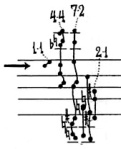Part 2 of the preview. Nonce at NEC 5/17, 8PM in Williams Hall. Do come.
Fresh ink from Vanessa Wheeler.
Tonight we will hear the premiere of Vanessa’s new quintet “Successions,” commissioned by the nonce ensemble. The piece is a lush and crackling soundworld that uses the ensemble brilliantly. What Vanessa describes as a “quiet noise piece for ensemble,” “Successions” divides the group into two duos (bassoon and voice; cello and sax), who play mostly independent material, in a sort of dialogue, wherein one set soaks itself in a rich stasis while the other bustles with activity, one asks a question while the other offers an answer. This conversation is elucidated by the violin, who acts independent of the others, prefiguring or echoing music found in the other pairs’ parts. The successions of events occur in roughly twenty-second intervals throughout the piece, in which each subset of the ensemble behaves a certain way, until, as the piece progresses, more and more the subsets cooperate – or contradict – each other as the composition approaches its climax, and when the violin finally must choose a side.
Vanessa worked intimately with the players to come up with extended techniques and notations that would work especially well for their instruments. Delving into bassoon and saxophone multiphonics and other parameters such as air pressure and lip placement, she creates a gently screeching and richly enveloping soundscape, an evolving texture of reedy winds blowing. The voice is given phonetic symbols for the various vowels and consonants, sounds and mouth-shapes, and Ceceilia’s body becomes a sonorant vessel for these gorgeous and strange tones. The strings comment on all of this through a tasteful employment of soft dynamics, scratch tones, the sound of wood, and subtle shifts in timbre.
Take a look at a page from the score. Here the sax and cello are in the supporting role, providing subtle points and echoes. The voice moves first in long, flowing lines atop an opening up of the bassoon’s multiphonic, settling into a small chromatic range while the bassoon moves four-part chords underneath, before the two split to the extremes of their ranges, swelling in a timbral-shifting wave. The violin moves in its own way, coinciding and interjecting amidst the other parts, until the sax and cello have their final say, with a beautiful chord of multiphonics and doublestops.
Walter Zimmermann is a unique outsider in the world of the European avant-garde. His piece, “Paradoxes of Love” for voice and sax, uses folk melodies, two-part counterpoint and canonic writing, subtle dynamic and timbral shifts, and Pythagorean tuning to create a commentary of love and coalescence that is mystical, primal, and simultaneously convincing and subversive in its narrative arc. Derek Beckvold and Ceceilia Allwein blend and contrast beautifully, oppose and complement as lovers do, in this duet on the 13th century Dutch poet and mystic Hadewjich. I’ll let her words speak for themselves:
Wordlessness is [love’s] most beautiful utterance;
Imprisonment by her is total release;
Her sorest blow is her sweetest consolation;
Her ruthless robbery is great profit;
Her withdrawal is approach;
Her deepest silence is her sublime song;
Her deepest wrath is her dearest thanks;
Her greatest threat is pure fidelity;
Her sadness is the alleviation of all pain.
[…]
After she first played these tricks on me,
And I considered all her methods,
I went to work in a wholly different way;
By her threats and her promises
I was no longer deceived.
I will belong to her, whatever she may be,
Gracious or merciless; to me it is all one!







